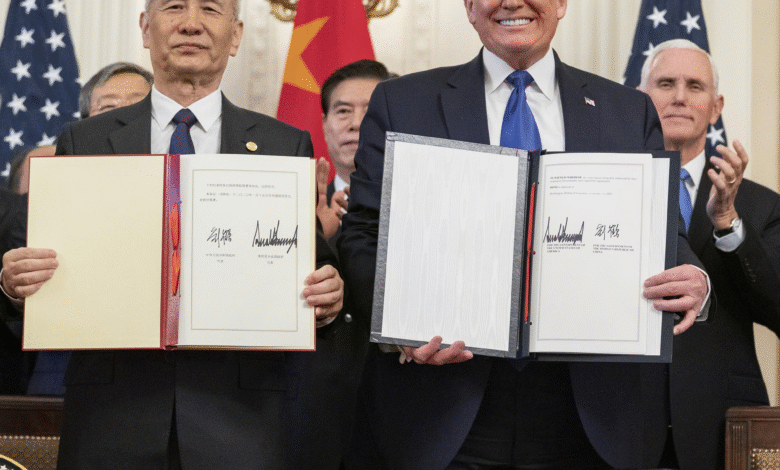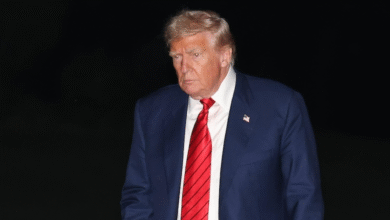China Trade Agreement: Key Details Revealed

The recent China trade agreement marks a significant milestone in the ongoing economic relationship between the U.S. and China. Following discussions held in London, both nations have laid out key trade agreement details that seek to implement the Geneva consensus. Notably, China has committed to reevaluating and approving export applications in line with stringent export control regulations, signaling a more structured approach to trade. In turn, the U.S. plans to lift a variety of existing restrictions affecting Chinese imports, a move that promises to reshape bilateral commerce. These developments come on the heels of President Trump’s remarks highlighting the signing of the U.S.-China trade deal, a crucial step toward enhancing cooperation and economic stability between the two global giants.
This new trade pact between the world’s two largest economies is set to redefine international trade dynamics. The recent U.S.-China trade deal not only addresses various tariffs but also updates regulations surrounding exports and imports critically impacted by governmental controls. By agreeing to these terms, both Beijing and Washington are moving away from tensions that have escalated in recent years. The agreement reflects a broader commitment to maintaining dialogue and collaboration in global trade, aligning closely with recent international consensus efforts. As both nations navigate the complexities of this accord, the importance of trade relations and regulatory compliance continues to be at the forefront.
Overview of the U.S.-China Trade Agreement
The recent U.S.-China trade agreement marks a significant milestone in the ongoing economic negotiations between the two largest economies in the world. Initially framed during discussions in London, this trade deal aims to bolster cooperation by implementing terms previously under the Geneva consensus framework. Both nations have committed to a series of reforms designed to enhance bilateral trade relations, signaling a potential thaw in trade tensions that have marked previous years.
Key highlights of the agreement include China’s pledge to review and approve export applications for numerous items while the United States prepares to lift certain existing export control regulations. This reciprocal approach not only aims to facilitate smoother trade operations but also represents a strategic shift towards fostering mutual economic growth between the U.S. and China.
Implications of Export Control Regulations in the Trade Deal
Export control regulations have long been a centerpiece of U.S.-China relations, shaping the trade landscape significantly. Under the new trade agreement, China’s commitment to review export applications reflects a readiness to comply with revised standards, which is expected to benefit American manufacturers reliant on Chinese suppliers. The alleviation of restrictive measures from the U.S. further emphasizes a cooperative spirit, potentially preventing further escalation of tariffs and other trade barriers.
Moreover, the synchronization of export regulations aims to enhance efficiency, reduce bureaucratic delays, and foster an environment of reliability for businesses operating in both markets. As the agreement unfolds, companies from both nations must stay informed to navigate the shifting regulatory landscape effectively, ensuring they remain compliant while maximizing their operational capabilities.
Analysis of Trump’s Remarks on the Trade Agreement
Recently, President Donald Trump made remarks regarding the U.S.-China trade agreement that have sparked interest and speculation across various sectors. His confirmation that both parties had signed the trade deal suggests a pivotal development in U.S. trade policy. While specific details remain sparse, such public affirmations may drive market confidence around both domestic and international investments.
Trump’s approach to the trade deal, focusing on themes of fairness and reciprocity, resonates with a broader base of American businesses eager for favorable trading conditions. However, the lack of detailed disclosure about the agreement raises questions regarding its implications, particularly for sectors heavily impacted by previous tariffs and restrictions. Observers anticipate that the trade agreement could redefine the strategic economic dynamics between the two nations.
Details of the Trade Agreement: What to Expect
The U.S.-China trade agreement is expected to encompass a range of economic policies targeting both tariffs and export protocols. Industry experts predict that the agreement will facilitate smoother trade transactions by lessening the economic strains observed in past years, particularly those resulting from conflicting tariffs. The specifics about how these changes will be implemented remain essential to understanding the long-term impacts on global trade flows.
Another crucial aspect anticipated from this trade deal includes provisions for safeguarding intellectual property and reducing barriers for U.S. firms seeking market access in China. As trade relations stabilize, businesses keen on exporting goods to China might find enhanced opportunities, while Chinese firms may also gain better access to the U.S. market. This reciprocal relationship underscores the potential for a more structured trading framework under the new agreement.
The Geneva Consensus and Its Role in the Trade Deal
The Geneva consensus plays a pivotal role in shaping the current U.S.-China trade agreement, serving as a foundational principle that both parties have acknowledged in their negotiations. This framework promotes multilateralism and cooperation, enabling countries to tackle shared challenges collectively. By aligning under the Geneva consensus, both the U.S. and China signal a commitment to constructive dialogue and collaborative engagement.
The incorporation of the Geneva consensus into trade discussions serves to reinforce a commitment to rules-based trade practices, emphasizing fairness and transparency. As both nations navigate the complexities of their respective economies, adhering to this consensus can help mitigate potential disputes and foster a more predictable trading environment, creating long-lasting benefits for both nations.
Future Outlook for U.S.-China Trade Relations
The future of U.S.-China trade relations will likely hinge on the successful implementation of the trade agreement and the mutual willingness to adapt to changing economic realities. As both nations embark on this new path, continuous dialogue will be crucial for addressing emerging challenges and disputes. Economists believe that ongoing collaboration can lead to enhanced trade volumes, benefiting industries on both sides.
In addition, stakeholders are encouraged to monitor how well each country complies with the terms of the trade deal, particularly regarding export controls and tariffs. As international markets respond to these developments, the U.S.-China relationship holds the potential to reshape global trade dynamics, achieving a balance that fosters economic growth while addressing national interests.
Understanding Key Terms: Export Control and Tariffs
In the context of the U.S.-China trade deal, understanding key terms such as export control and tariffs is essential. Export control refers to the regulations governing what goods can be traded between nations, particularly sensitive technologies that may impact national security. Both countries are expected to make significant adjustments regarding these controls under the new agreement, which aims to facilitate trade while maintaining necessary safeguards.
Tariffs, on the other hand, are taxes imposed on imported goods, which have been a point of contention in U.S.-China trade relations. Reduced tariffs stemming from this agreement could stimulate economic activity by lowering the costs associated with imported products. Monitoring these developments will offer valuable insights into the health of the bilateral trading environment and the potential for further negotiations.
The Role of Business in the Trade Agreement
Businesses will play a crucial role in the success of the U.S.-China trade agreement, as they adapt to the new regulations and opportunities presented. Engaging with policymakers and providing feedback on the practical implications of the deal will help ensure that the agreement meets the needs of industries on both sides. By fostering a collaborative environment, businesses can greatly assist in preventing misunderstandings that could arise in the implementation phase.
Additionally, as firms begin to navigate the nuances of the trade agreement, they must remain vigilant and responsive to ongoing changes in export controls and tariffs. The active participation of businesses in shaping future trade dialogues will contribute to a more balanced and beneficial trading landscape for both nations.
Conclusion: Navigating the New Trade Landscape
In conclusion, the U.S.-China trade agreement represents a transformative moment in international trade relations. As both countries embark on strategically aligned economic cooperation, effective navigation of this new landscape will be crucial for businesses, policymakers, and economists alike. The implications of the agreement extend beyond bilateral trade, potentially influencing a broader global economic context.
It is vital for stakeholders to stay informed about the details of this trade deal, particularly as they pertain to export controls and tariff structures. By leveraging the provisions outlined in the agreement, both nations have the opportunity to build a more resilient economic partnership, fostering growth and innovation in the years to come.
Frequently Asked Questions
What are the key principles of the U.S. China trade deal?
The U.S. China trade deal is centered around the Geneva consensus, which emphasizes mutual respect and cooperation between both nations. Key principles include tariff adjustments, export control regulations, and commitments to increase trade and investment.
How will the new export control regulations impact the China trade agreement?
As part of the China trade agreement, the new export control regulations will streamline the review and approval process for exports from the U.S. to China, facilitating smoother trade relations.
What did Trump say about the China trade agreement during his remarks?
During his remarks, President Trump confirmed that the U.S. and China had signed the trade deal and expressed optimism for economic growth and enhanced bilateral cooperation, though he did not provide specific details.
Can you explain the trade agreement details mentioned by China’s Ministry of Commerce?
The trade agreement details include China’s commitment to review export applications under the new export control regulations and the U.S. decision to revoke various restrictive measures imposed previously, promoting a more open trade environment.
How does the U.S. China trade deal align with the Geneva consensus?
The U.S. China trade deal aligns with the Geneva consensus by focusing on fair trade practices, cooperative economic policies, and adherence to global trade norms, enhancing long-term stability in U.S.-China relations.
What are the implications of the U.S. revoking restrictive measures on the China trade agreement?
Revoking restrictive measures against China is seen as a move to foster better trade relations and trust, making it easier for businesses to engage and expand their operations under the new China trade agreement framework.
| Key Points | Details |
|---|---|
| Trade Agreement Clarification | The U.S. and China clarified details of the trade agreement reached in London, consistent with the Geneva consensus. |
| Review of Export Applications | China will review and approve export applications for items that are subject to export control regulations. |
| Revocation of Restrictive Measures | The U.S. will revoke a range of existing restrictive measures imposed against China. |
| Official Statements | The announcement was made by China’s Ministry of Commerce, and confirmed by U.S. President Trump during a White House event. |
Summary
The China trade agreement marks a significant step forward in U.S.-China relations. This agreement underscores the commitment of both nations to rectify trade imbalances and enhance cooperative efforts in international trade. With China agreeing to carefully review export applications and the U.S. revoking existing restrictions, both countries aim to foster a more collaborative trade environment. This evolving relationship will have far-reaching implications for global markets, as the two largest economies in the world continue to negotiate and refine their agreements.




